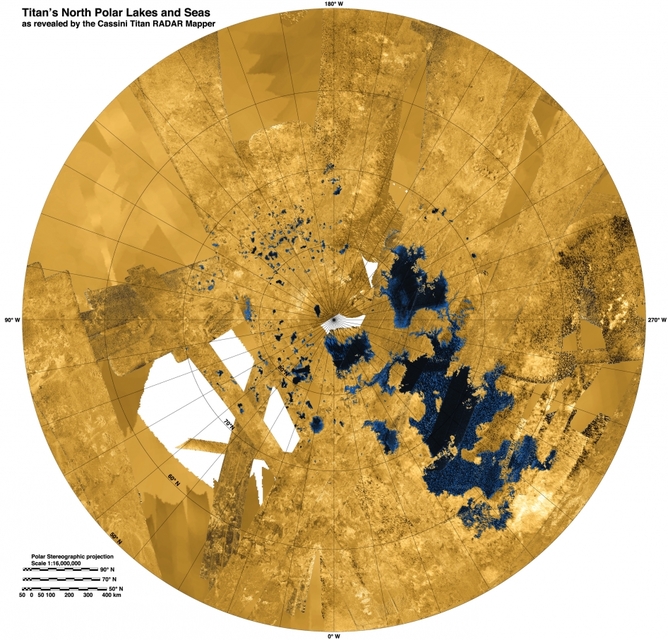

The joint NASA-ESA Cassini space probe, exploring Saturn and her moons, has revealed extraordinary lakes and seas of liquid methane around the north pole of Titan. Scientists associated with the Cassini mission described a strange rectangular area of large seas, picked out by imaging instruments aboard the probe.
Elongated lakes and seas connected by long skinny peninsulas characterise the two seas picked out in the new image. Reminiscent of the topographic depressions in the basin and range province of USA, shaped by the movements of tectonic plates on America’s western fringe, there are suggestions that the large lakes seen on Titan may be tectonically shaped-seas.
“Scientists have been wondering why Titan’s lakes are where they are. These images show us that the bedrock and geology must be creating a particularly inviting environment for lakes,” said Randolph Kirk, a Cassini RADAR team member at the US Geological Survey. “We think it may be something like the formation of the prehistoric lake called Lake Lahontan near Lake Tahoe in Nevada and California, where deformation of the crust created fissures that could be filled up with liquid.”
Scientists described the observations of huge polar lakes called Ligeia and Kraken on Titan, at the meeting of the American Geophysical Union here in San Francisco today, the world’s largest gathering of Earth scientists.
Alongside the two large liquid bodies picked out so clearly, there is a myriad of smaller lakes that are seen scattered around the pole of Titan. Their origins are unclear, with speculations ranging from volcanic crater lakes to giant sinkholes formed in dissolved Titan crust.
Marco Mastrogiuseppe from Sapienza University, Rome, described the results from RADAR imaging of the fluid bodies at Titan’s surface. “For the first time we were able to observe the topography of the subsurface of an extraterrestrial sea”, he explained.

Cassini soaring over Titan
Cassini’s RADAR has charted the areas of the lakes and seas near the pole, but has also bounced signals off the lake beds in the first depth soundings of an extraterrestrial sea.
“Ligeia Mare turned out to be just the right depth for radar to detect a signal back from the sea floor, which is a signal we didn’t think we’d be able to get,” said Mastrogiuseppe. A maximum depth of around 170 meters, similar to Lake Michigan, was found, and the lake was crystal clear to RADAR eyes.
The total volume of Ligeia is put at 9000 cubic kilometres and it is filled not with water, but with hydrocarbon fluids. The total volume of the hydrocarbon Titanic seas corresponds to around 300 times that of Earth’s oil reserves, in a celestial body smaller than Earth.
The RADAR reflectivity suggests that the lakes are mainly filled with methane alongside a few other heavier hydrocarbon fluids. These include ethane and nitrogen. Alongside Ligiea sits another sea, Kraken. Comparable in size to the Caspian Sea here on Earth, Kraken is four or more times the area of Ligeia. Cassini will return to carry out bathometry of it in August 2014.
Jeffrey Kargel, from the University of Arizona Tucson, pointed out that the presence of extensive methane seas and lakes at Titan’s north pole makes worse a long acknowledged deficiency of heavier hydrocarbons expected from models of Titan’s chemistry. Among them are ethane, ethylene, propylene, acetylene and benzene – heavy hydrocarbons generated as sunlight causes chemical reactions in Titan’s soup of natural gas. Using visual imaging instruments Cassini has revealed that Titan has a northern polar cap larger than Greenland.
Bright deposits around the lakes show the nature of the solid surface. In a world that is difficult to imagine, crystallised heavy hydrocarbons form Titan’s crust, with suggestions of huge dune fields of solid hydrocarbon sand around the equator. While these equatorial “rocks” are saturated in ethane the polar regions appear to be made of methane.
We are now close to summer solstice on Saturn, and Titan has weather that changes with the seasons. Giant storms arise on Saturn, with jets of gas seen shooting from the south pole of cousin moon, Enceladus. A fly-by is planned in 2015 in which Cassini will fly through these plumes and take a closer look at Enceladus’ north pole.
Cassini is now in a set of intricate complicated orbits. Only 4% of its propulsion is left, and future fly-bys are largely powered by the gravitational fields of Saturn and its moons. The probe’s final journey, planned for September 2017 will skirt Saturn’s innermost ring and touch her atmosphere before finally succumbing to the giant planet’s grasp.
Simon Redfern does not work for, consult to, own shares in or receive funding from any company or organisation that would benefit from this article, and has no relevant affiliations.

This article was originally published at The Conversation. Read the original article.
